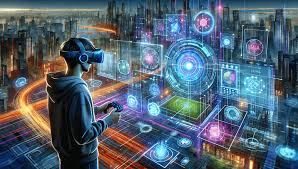The Future of Virtual Reality in Gaming: Innovations and Possibilities 
Virtual reality (VR) has emerged as one of the most transformative technologies in the gaming industry, offering immersive experiences that transcend traditional gaming. As technology continues to evolve, the future of VR in gaming promises to reshape how players interact with virtual worlds, connect with others, and experience storytelling. This comprehensive analysis explores the current state of VR in gaming, the innovations on the horizon, and the potential impact on players and the industry as a whole.
- Understanding Virtual Reality
1.1 What is Virtual Reality?
Virtual reality is a computer-generated environment that allows users to interact with a three-dimensional space using specialized equipment such as VR headsets, gloves, and motion trackers. Unlike traditional gaming, where players interact with a screen, VR immerses them in a simulated environment, creating a sense of presence and engagement.
1.2 Current State of VR in Gaming
The VR gaming landscape has grown significantly since the release of early headsets like the Oculus Rift and HTC Vive. Today, a variety of platforms and games cater to different audiences, ranging from casual gamers to dedicated enthusiasts. Titles such as “Beat Saber,” “Half-Life: Alyx,” and “The Walking Dead: Saints & Sinners” have showcased the potential of VR, offering unique gameplay experiences that leverage the technology’s immersive capabilities.
- Key Innovations in VR Technology
2.1 Advancements in Hardware
As VR technology advances, the hardware supporting it has also improved. Key innovations include:
- High-Resolution Displays: Modern VR headsets now feature higher resolution displays, reducing the “screen door” effect and enhancing visual fidelity. Companies like Oculus and Valve are continually working on improving resolution and refresh rates to create more lifelike experiences.
- Wireless Capabilities: Wireless VR headsets, such as the Oculus Quest 2, have gained popularity by eliminating cumbersome cables, allowing for greater freedom of movement. This trend is expected to continue, enabling more immersive gameplay.
- Improved Motion Tracking: Enhanced motion tracking technologies, including inside-out tracking and external sensors, provide more accurate and responsive gameplay. This innovation allows players to move freely within the virtual space without losing tracking fidelity.
2.2 Haptic Feedback and Sensory Enhancements
Haptic feedback technology is evolving, providing players with tactile sensations that enhance immersion. Future VR games are likely to incorporate advanced haptic suits, gloves, and accessories that simulate the sense of touch, enabling players to feel the weight of objects, the impact of actions, and even environmental sensations like wind or heat.
2.3 Artificial Intelligence and Machine Learning
Artificial intelligence (AI) and machine learning are poised to revolutionize VR gaming by creating more responsive and dynamic game environments. AI can enable:
- Intelligent NPCs: Non-playable characters (NPCs) can react more realistically to player actions, making the virtual world feel more alive and interactive.
- Personalized Experiences: AI can analyze player behavior and preferences to tailor gameplay experiences, offering customized challenges, narratives, and environments that enhance engagement.
- The Role of Social Interaction in VR Gaming
3.1 Immersive Multiplayer Experiences
One of the most exciting aspects of VR gaming is its potential for social interaction. As players engage with friends and strangers in shared virtual spaces, new forms of multiplayer experiences are emerging. Innovations include:
- Virtual Gatherings: Platforms like VRChat and AltspaceVR allow users to meet, socialize, and participate in various activities in a virtual environment, simulating real-world social interactions.
- Cooperative Gameplay: VR games that emphasize teamwork and collaboration, such as “Rec Room” and “Phasmophobia,” create a sense of camaraderie among players, fostering deeper connections and shared experiences.
3.2 Building Virtual Communities
As VR technology becomes more accessible, the creation of virtual communities is likely to flourish. These communities can serve as spaces for:
- Creative Expression: Players can create and share their own content, from custom game levels to virtual art installations, enhancing the social fabric of the VR ecosystem.
- Support and Connection: Virtual spaces can provide support networks for individuals with shared interests, fostering connections that transcend geographical boundaries.
- The Evolution of Storytelling in VR Games
4.1 Immersive Narrative Experiences
Virtual reality offers unique opportunities for storytelling, allowing players to become active participants in narratives rather than passive observers. Key trends in storytelling include:
- Branching Narratives: VR games can incorporate branching storylines that respond to player choices, creating personalized experiences that encourage exploration and replayability.
- Environmental Storytelling: The immersive nature of VR allows for environmental storytelling, where players can discover narrative elements through their surroundings, enhancing engagement and emotional investment.
4.2 Emotional Engagement
VR has the potential to evoke stronger emotional responses compared to traditional media. By placing players in emotionally charged situations, developers can create powerful experiences that resonate on a deeper level. Games like “Half-Life: Alyx” have demonstrated how VR can enhance tension and emotional engagement through immersive gameplay mechanics.
- The Future of VR Game Development
5.1 Indie Game Development
The democratization of VR technology is enabling indie developers to create innovative experiences without the constraints of large studios. As VR becomes more accessible, a diverse range of voices and perspectives is likely to emerge, leading to unique and experimental games that challenge traditional gaming conventions.
5.2 Cross-Platform Play
Future VR games are expected to embrace cross-platform play, allowing players on different devices to interact seamlessly. This inclusivity can expand player bases and foster vibrant gaming communities, ensuring that VR gaming remains engaging and diverse.
5.3 Integration of Augmented Reality (AR)
The line between VR and augmented reality (AR) is increasingly blurring. Future games may incorporate elements of both technologies, allowing players to interact with virtual elements in their physical environments. This hybrid approach could lead to innovative gameplay experiences that transcend traditional boundaries.
- Challenges Facing VR in Gaming

6.1 Motion Sickness and Discomfort
One of the primary challenges facing VR gaming is motion sickness, which can occur when there is a disconnect between visual movement and physical sensations. Developers are exploring solutions, such as optimizing frame rates, improving motion tracking, and incorporating teleportation mechanics, to mitigate discomfort.
6.2 Accessibility and Affordability
While VR technology has advanced, the cost of high-quality VR setups can be prohibitive for many potential players. Ensuring that VR gaming is accessible to a broader audience will be crucial for its long-term growth.
6.3 Content Creation
The demand for high-quality VR content is rising, but developing engaging and immersive VR experiences is a complex and resource-intensive process. Developers will need to balance innovation with sustainability to meet player expectations.
- The Potential Impact of VR on Other Industries
7.1 Education and Training
VR’s immersive capabilities extend beyond gaming into fields such as education and training. Simulated environments can provide hands-on learning experiences for students and professionals, enhancing understanding and retention.
- Medical Training: VR simulations allow medical students to practice procedures in a safe environment, improving skills and confidence.
- Vocational Training: Industries like construction and aviation can use VR to train employees on equipment and safety protocols without the risks associated with real-world training.
7.2 Healthcare and Therapy
Virtual reality is being explored as a therapeutic tool in healthcare. Applications include:
- Exposure Therapy: VR can be used to help patients confront phobias and anxiety disorders in a controlled and safe environment.
- Pain Management: Immersive VR experiences have shown promise in distracting patients from pain during medical procedures or rehabilitation.
- Conclusion

The future of virtual reality in gaming is rich with possibilities and innovations. As technology continues to evolve, players can expect increasingly immersive experiences that redefine how they interact with virtual worlds, engage with narratives, and connect with others. While challenges remain, the potential for VR to revolutionize gaming and beyond is undeniable.
By embracing these advancements, the gaming industry can create more inclusive, engaging, and transformative experiences for players worldwide. As VR technology becomes more integrated into everyday life, its influence will extend far beyond gaming, shaping education, healthcare, and social interactions in profound ways. The journey of virtual reality is just beginning, and the possibilities for the future are limitless.

